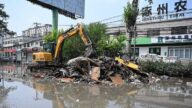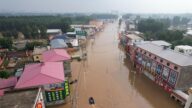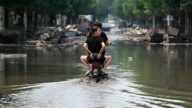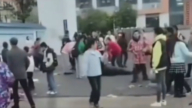【新唐人2012年7月24日讯】21号,北京遭遇61年来最强暴雨,城区到处积水,很多市民和车辆被围困水中。官方通报,暴雨已造成37人死亡,7人失踪。水灾中,当局救援不力、城市排水系统严重落后等问题被暴露无遗。大陆媒体批评:在城市发展中,当局一直只重视城市外表,不重视地下排水等设施的建设,是典型的“要面子,不要里子”。
7月21号北京市区的这场暴雨,平均降水量达每小时170毫米。暴雨之下,北京市区从二环到四环,20多座立体交叉桥积水,交通中断,很多汽车被淹没。
当天的525架次航班被迫取消,机场地铁线也因大雨中断营运,大量旅客滞留机场。
受灾严重的房山区则有山洪暴发,河堤被损坏、河水外溢,有村庄被洪水围困。
官方通报,截至23号,已有37人因暴雨死亡,7人失踪。暴雨造成经济损失近100亿,有近两万辆汽车受损。
但网友对官方的统计数据表示质疑。家住房山龙宝峪的网友爆料说:这边死了200人都不止,边上大棚住的人家全都空了,一片废墟,连棺材都在马路中间挡着。有个小女孩(刚)下917(路公交)直接被水冲走了,没人救援,没人报导。
民众对当局的施政能力也感到非常不满,网友写道:居民淹死在二环快车道上,这简直是北京市执政者的耻辱!
媒体揭示,北京排水系统的设计标准很低,只能应对1到3年一遇的降雨。存在的问题包括:设施建设滞后,设施老化,管理缺陷造成地下设施无法安全运行等。
而由于城市规划不合理,挤占了排水系统的升级空间,造成中国部分城市的排水系统很难大幅升级。上海《东方早报》报导指出,中国在以前的发展中,一直是“重地上、轻地下”,只重视城市外表,不重视地下排水等设施的建设,“要面子,不要里子”。
北京市民华颇:“北京搞到很光鲜,是为增加自己(官员)往上爬的资本。那就得让人看得着,而地底下是看不着的。”
但相比现代北京城的“每逢暴雨就成灾害”,故宫西北角外的古城池——北海团城,虽同样位处暴雨中心,却无丝毫积水。团城内600年前明代所建的排水系统,仍然运作良好,地面只是稍显潮湿而已。
对此,深圳独立作家朱健国向《新唐人》表示,官方一直号称要“以民为本”,实际上是“以党为本”、“以官为本”。
朱健国:“对老百姓的重视程度还不如明代嘛!明代的北京城、清代的北京城,那时候大雨暴雨的防水体系的建设都还高于现在。”
朱健国指出,官方并没有吸取教训,而是再一次杜绝了老百姓的监督和批评,到现在为止,没有一个执政者出面道歉,这才是真正的问题。
朱健国:“现在反而把北京暴雨当成一个感动,当成一个表扬,丧事当成喜事来办。那么这就可以预料,北京还将继续在暴雨的侵害之中。”
当局的作为激发民众的愤怒,有网民怒批当局:只建看得见的地上高楼,不管城市排水道﹔只做形象工程北京奥运、上海世博会、神九上天,不管百姓水深火热!
朱健国:“那么北京暴雨,现在看来,不是淹了北京城。而是民怨淹了北京城。它激起了更大的民愤 。”
去年(2011年)6月23号,北京在遭遇大雨后,地铁被淹,首都机场和故宫汪洋一片。当时民众嘲讽说:“到北京来看海。”
采访/刘惠 编辑/李谦 后制/萧宇
Beijing Criticized for Ignoring Drainage: Storm Causes 37 Deaths
On July 21, Beijing experienced
its strongest rainstorm in 61 years.
The city is now full of stagnant water, and many
people and vehicles were trapped by the water.
Official media reported that the rainstorm
has caused 37 deaths, with seven people missing.
Serious issues have been exposed, such as a lack of rescue
response from authorities, and a poor urban drainage system.
Chinese media criticised that the Chinese Communist Party
(CCP) authorities only pay attention to city appearance in urban development,
and ignore the construction of underground drainage
facilities. It is a typical CCP act to “to brush up the outside.”
The average rainfall per hour during the storm was 170 mm.
Over 20 highway bridges are standing in stagnant water.
Traffic is disrupted and a lot of cars were submerged.
525 flights were cancelled, and the subway station at the
airport is closed. Many travelers are stranded at the airport.
Fangshan District has been seriously impacted. There were
floods in the mountain areas, and the flood embankments were damaged.
The river overflowed, and villages
were trapped by flood water.
Official media reported that up until July 23,
37 people had died, and seven are missing.
The rainstorm has caused nearly 100 million yuan
in damages, and nearly 10,000 cars were damaged.
Netizens have doubts over the official data.
One netizen who lives in Fangshan Longbaoyu said that,
“over 200 people died here. The tent areas are empty.
The area has nothing left. A little girl was washed away.
There is no rescue or report on it."
People are also very unhappy
about the government’s rescue response.
One netizen wrote that some people were drowned
on the fast lane of the Erhuan highway.
This is a disgrace for the government.
Some media revealed that the design
of Beijing’s drainage system is poor.
It can only handle heavy storms,
which happen once every three years.
Issues surrounding the drainage include delayed construction,
outdated facilities, poor management and unsafe operation of underground systems.
Incorrect city planning meant that there was not room
provided for a drainage system upgrade.
Shanghai East Morning newspaper reported that China’s
development has been focusing on above the ground.
The CCP only pays attention to the external (It’s face).
Beijing citizen Hua Po: “Beijing looks nice.
The officials only think about getting promoted.
They pay attention to what people can see.
Under the ground is not visible.”
In comparison with modern Beijing’s disaster,
the ancient North Sea Tuancheng,
located at the northwest corner of the Palace Museum,
has no flood waters at all.
The drainage system was built 600 years ago
during the Ming Dynasty, and still operates well.
Only the surface of the ground is a little wet.
Independent writer Zhu Jianguo from Shenzhen told NTD
that the official statement of “for the people” is actually “for the CCP” and “for the officials.”
Zhu Jianguo: “Their attention towards people
is less than those in the Ming Dynasty.
Beijing in the Ming and Qing Dynasties
had a better system.”
Zhu Jianguo pointed out those officials did not learn their lesson.
They only stopped people’s criticism and monitoring.
Up until now, no official has stepped
out to apologize. This is the real fact.”
Zhu Jianguo: “The officials use Beijing’s storm
as an opportunity to praise themselves.
We can expect that Beijing will
continue to suffer during storms.”
What the authorities have done has caused anger from people.
Some netizens criticized that they only see high rise buildings above.
They do not care about the drainage system.
They only work on projects to brush up its image,
such as the 2008 Olympics, the World Expo, Satellites, etc.
They do not care about people’s lives.
Zhu Jianguo: “The storm in Beijing will not drown Beijing.
But people’s anger will. This is the true disaster.”
During last year’s storm on July 23rd 2011,
the subway system was drowned.
The Beijing airport and the Palace Museum were in water.
Netizens joked: “Come to Beijing to see the sea.”




























